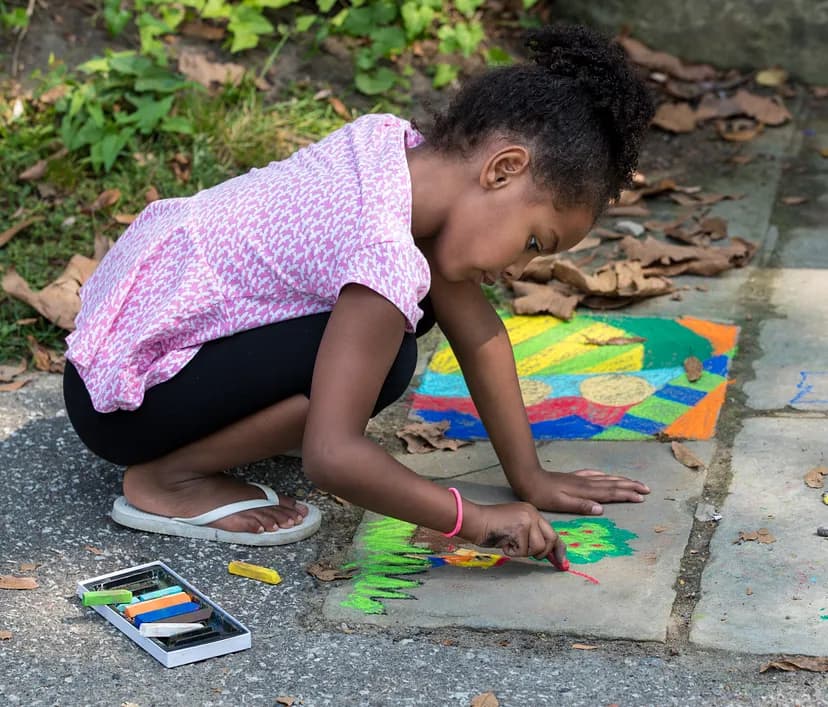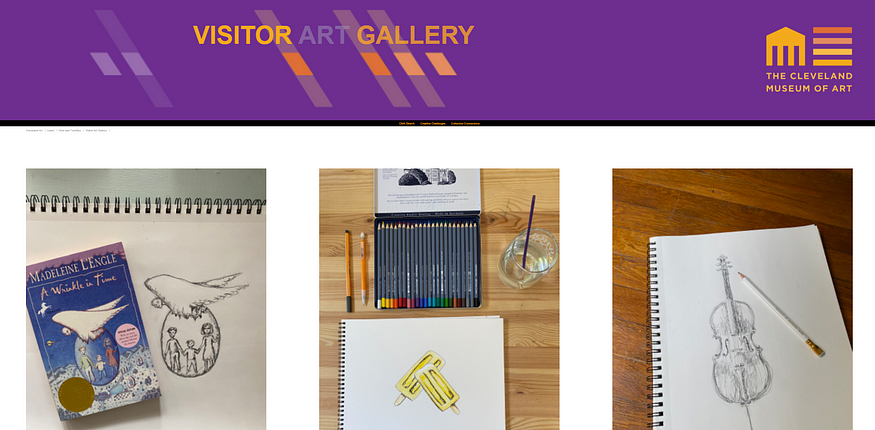Chalk and Coffee Beans: Making Art an Everyday Exercise
- Blog Post
- Education
- Events and Programs

Image courtesy Howard Agriesti for the Cleveland Museum of Art.
Creativity is a skill that everyone can practice. It’s like a muscle that can be stretched and strengthened. Creativity is empowering because it is grounded in play, joy, and wonder. It feeds us. Stimulating the creative mind happens in the exercise between imagination and guidelines. I like to think about guidelines not as boundaries but as fun challenges pushing us to re-imagine something.
As a creative professional myself, I thrive upon prompts that spark ideas that are then followed by a process of establishing my own rules — and then breaking them. I often think, “How far can I really push this concept?” Working within real and imagined parameters helps to guide my creative decision-making. I often get a result that looks nothing like I anticipated.
The importance of cultivating environments where art making can thrive is even more important in our unpredictable world today, especially for our children. We are dedicated to collaborating with our community and engaging in careful looking, questioning, and art making while connecting with art from our collection. Over the summer of 2020 we have created specific creative exercises, and there are more to share with the CMA community this fall.
Virtual Chalk Festival

This year marks the 31st Annual Chalk Festival at the CMA. To connect our community while maintaining safety procedures in the COVID-19 pandemic, the CMA will curate a virtual art making festival on Saturday, September 12, and Sunday, September 13.
The festival’s theme, Love Your Community with All Your Art, invites everyone to express their meaning of community in a colorful chalk drawing on their sidewalk or driveway. Inspiration may come from front porch concerts, community gardens, neighborhood architecture, or a favorite nature spot. You can connect your creativity to the CMA collection by visiting the CMA galleries, viewing the museum’s collection online, or taking a virtual tour on the ArtLens App. Participants can share their chalk drawings on Facebook and Instagram using the hashtag #CMAChalkFestival.

The CMA’s Chalk Festival brings an Italian Renaissance tradition to Cleveland. In 16th-century Italy, beggars used charcoal and chalk to draw on market plazas outside of churches. They often replicated church paintings of the Madonna and became known as I Madonnari. Today, this artistic tradition is celebrated annually in Europe, Africa, and the United States. The CMA’s Chalk Festival is the second oldest in the US.

Creative Challenges
The Italian beggars used chalk because it was a cheap and available material. As we’ve continued to work from our respective homes, the CMA’s learning and engagement team has imagined ways that common and inexpensive household items might be re-imagined as open-ended materials for art making. Our Creative Challenges prompts have asked participants to recreate an artwork using unexpected materials such as rocks, aluminum foil, salt and pepper, masking tape, toothpicks, and baking flour.

Our team has discovered that a kitchen full of baking supplies and spices provides an especially interesting inspiration. For example, one prompt asks people to recreate Tomb Guardians with kitchen utensils.

When brainstorming, we try to honor the materials for their unique qualities. Frequently, I walk around my apartment, opening drawers and cabinets to get inspiration from the objects within. What might be an exciting artwork to make with coffee beans? As I do the challenges myself, it’s remarkable how new relationships can grow. Because the materials are so unusual and unrelated to the respective work of art, there is much less pressure to create an exact, perfect replica. The fear of failure completely disappears, and you can truly enjoy the process.
We will create more of these Creative Challenges this fall shared via the museum’s Instagram (opens in a new tab) account and website. They may seem like playful prompts, but they reflect the larger importance of navigating boundaries in new ways, embracing ambiguity, and participating in the creative process joyfully. Practicing creativity when the stakes are low allows us to use and to recognize these skillsets in other circumstances with greater confidence. You can share your creations by uploading images of your art to our online Visitor Art Gallery.


Virtual Classes and Workshops

If you would like a bit more guidance for your creativity, the CMA offers several live virtual classes and workshops for kids, teens, and adults this fall. Our virtual studio programming gives people the opportunity to connect with our collection through collaborative dialogue, hands-on art making, and personalized instruction. These virtual classes and workshops are led by experienced teaching artists who model the creative process and help participants explore new ideas and materials. The open-ended prompts in these classes are meant to be bent, pushed, and pulled by people using their own experiences and knowledge to navigate the making process. In this collaboration, participants can be inspired by one another.

So often creativity thrives in spaces where ideas can be shared freely. The purpose and comfort in these interactions are important to our emotional well-being. During the COVID-19 pandemic, our team has adapted and pivoted to a virtual format so that we can continue to create transformative experiences with art, for the benefit of all the people forever. Creativity remain vital to our everyday lives — even when our every day lives are looking different every day.

Questioning and experimenting lead to new insights. Creating art out of everyday materials is a way to structure our immediate environment. While our world and circumstances remain quite unpredictable, we hope people will continue to look to the CMA as a resource for inspiration, hope, and joy.
Use these hashtags on social media to share your artwork with us!
#OurCMA
#CMAChalkFestival
#CMACreate
#CMASketch